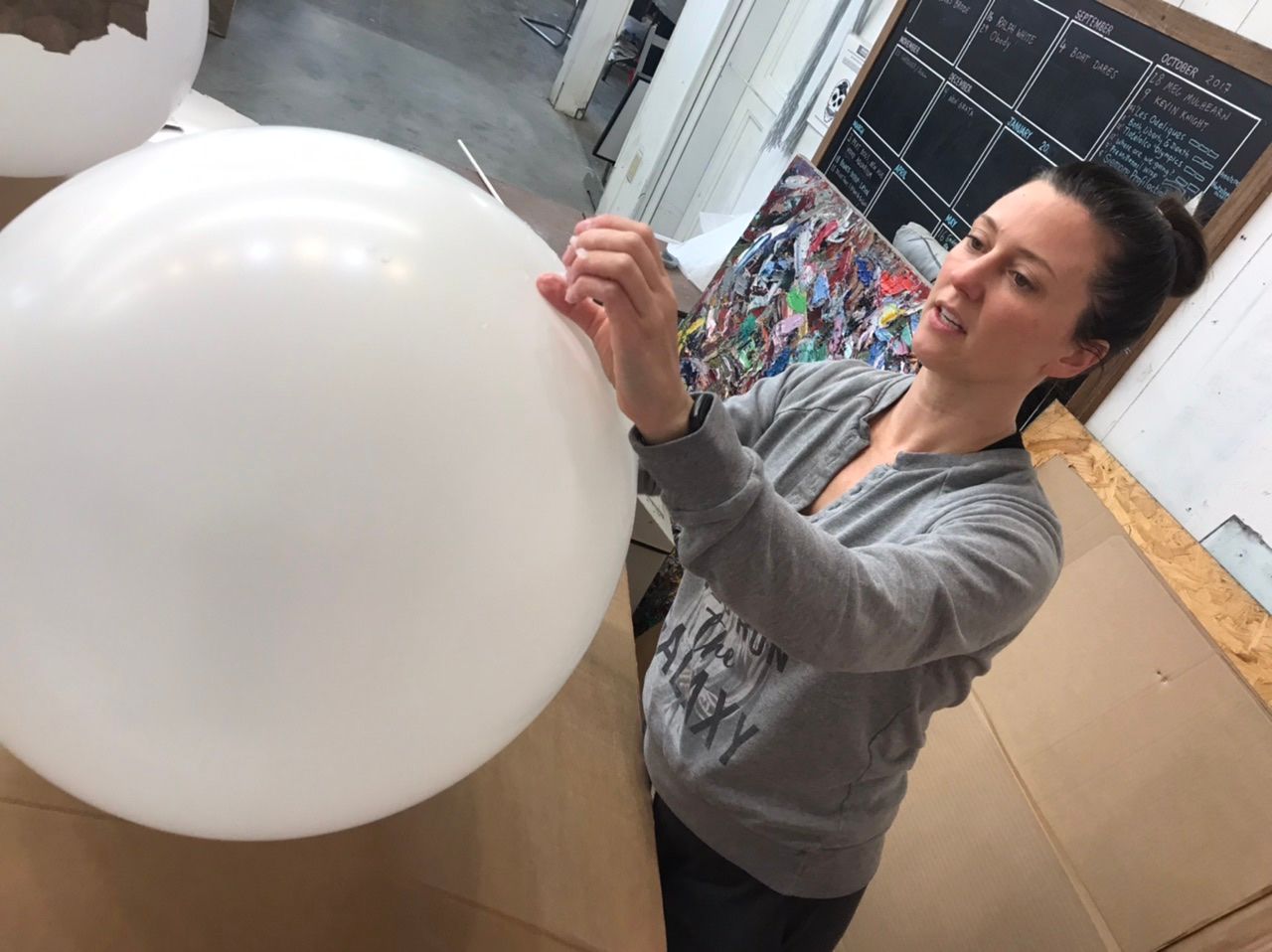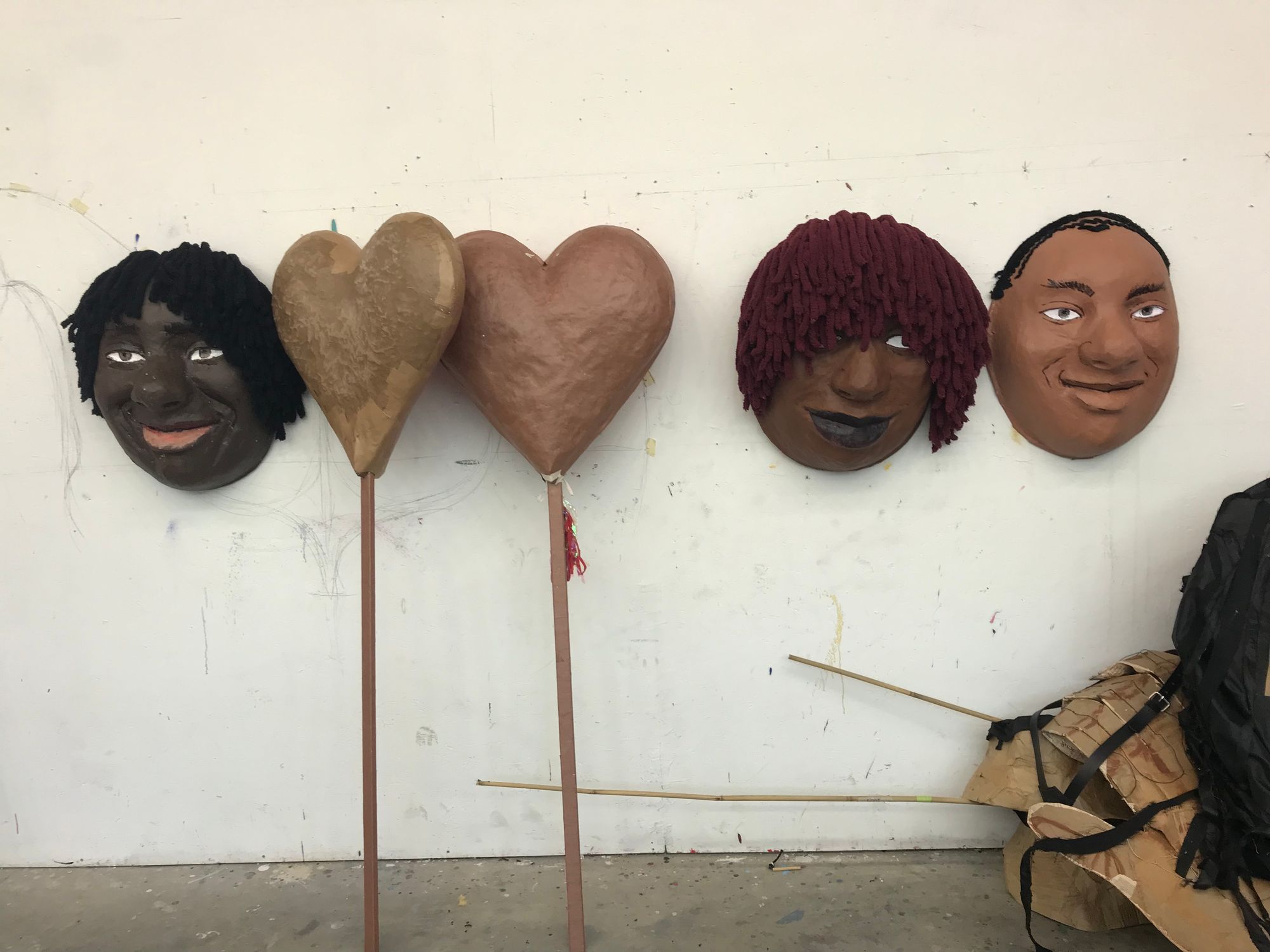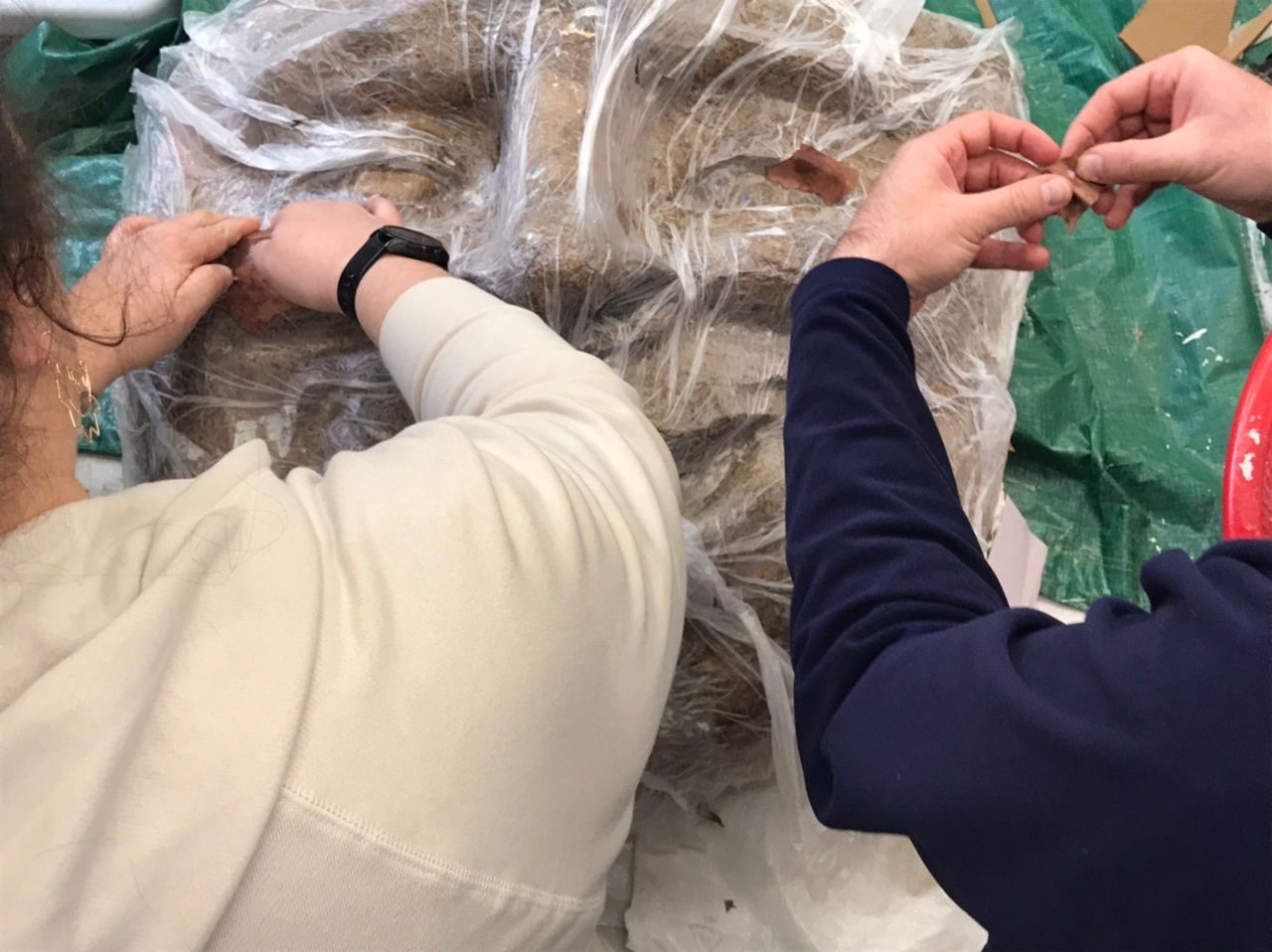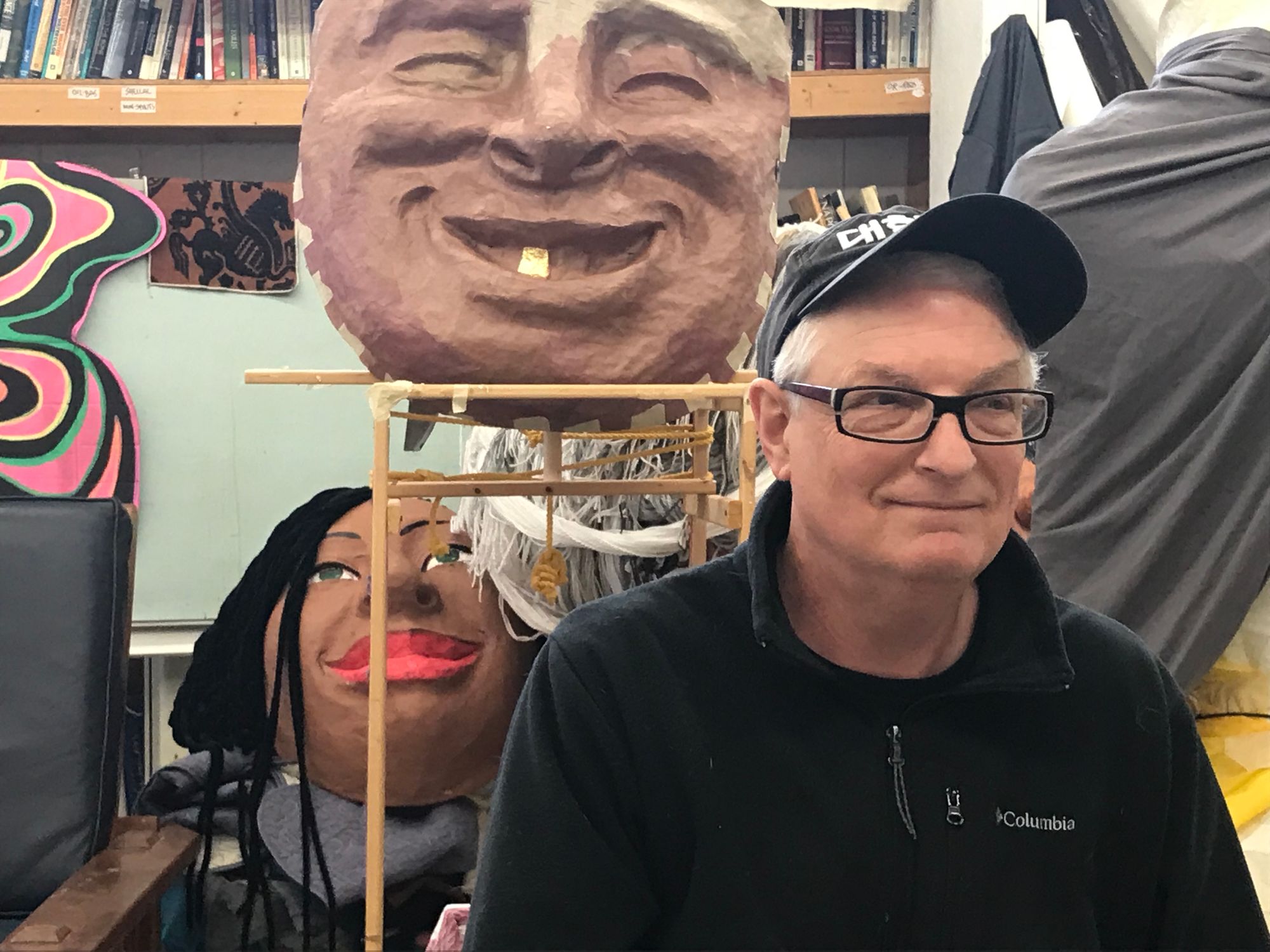Daisy Art Parade Float Bringing Mardi Gras Whimsy Through Downtown Roanoke
The parade seeks to demonstrate the ability of art and artistic expression to unite disparate people, communities and neighborhoods.

Sometimes, to make great art, you need a recipe: A little corn starch, some water, scraps of paper and a whole lot of giant balloons.
The scene inside a Southeast Roanoke art studio resembled a kids’ art class as Shaleen Powell pulled messy strips of paper from the corn-starch goop, slapped them onto the large, white balloons. When finished, the papier-mâché blimps will look like bumblebees, which will then be attached to a giant beehive.
But her art project wasn’t just for crafty fun. The hive will make a beeline through downtown Roanoke on Saturday, as part of the inaugural Daisy Art Parade of puppets, floats and other odd characters and their creators.
“We want to pollinate the community with arts,” said Powell, executive director of the Roanoke Culture Endowment, who believes the parade will bear artistic and civic fruit.
The whole studio was abuzz a couple of weeks ago, as volunteers made giant masks to be part of the parade, the brainchild of Brian Counihan, a Roanoke artist and educator who has some experience directing eclectic artsy gatherings.
From 2008 until 2014, Counihan organized Roanoke’s Marginal Arts Festival, a celebration of offbeat art and artists who created it. The festival always included a Mardi Gras-inspired parade that featured giant sculptures, winged fairies, circus-style acts and other non-mainstream attractions. Memorable works that rolled through downtown Roanoke included an enormous pair of clown shoes built by sculptor Ralph Eaton, who years earlier kicked off the first parade with a giant rat sculpture dubbed “Art Rat.”
But where the Marginal Arts Festival was a fun celebration of the outlandish, Saturday’s Daisy Art Parade has a more ambitious objective: to demonstrate, with the support of grants and public funds, the ability of art and artistic expression to unite disparate people, communities and neighborhoods.
“The parade itself is a sign that work is being done,” Counihan said. “Making this art requires four or five people getting together, getting to know one another, meeting people you wouldn’t meet, and creating something. It’s like a barn raising. People share different skill sets. You put four or five ideas together and you build momentum. You build bridges.”
Year of the Artist
Counihan sat for an interview inside Eaton’s Art Rat studio, a name inspired by the sculptor’s large rat that led the Marginal Arts Parade back in 2008. The studio space is housed in an old brick building on the sprawling industrial property that once was home to the American Viscose Co. in Southeast Roanoke, a place that developer Ed Walker wants to turn into a housing and retail complex called Riverdale.
For weeks, Counihan has worked with artists and other volunteers who have helped make papier-mâché faces and other pieces for the parade. The place resembled a warehouse of mini-Mardi Gras floats, as Counihan sat surrounded by giant masks colored in diverse tones, some of which will be part of oversized costumes for parade participants.

Counihan is Roanoke’s Neighborhoods of Opportunity artist in residence for Southeast Roanoke, a one-year position funded with grants and administered by the United Way of Roanoke Valley. Part of his mission has been to engage with the people and neighborhoods of Southeast Roanoke, a once-thriving industrial slice of the city whose residents have long felt neglected and overlooked by Roanoke leaders.
Counihan’s residency coincides with the Year of the Artist, a designation made by the Roanoke Arts Commission as a way to bring artists and the communities where they live together.
The Year of the Artist project is funded by $300,000 received from the National Endowment for the Arts as part of the American Rescue Plan Act, which provided relief through the pandemic, along with some city arts funding.
The Year of the Artist, the Daisy Art Parade and other artistic endeavors are part of a citywide cultural outreach that for a few years has used artistic expression as a way to accomplish wide-ranging civic goals from bringing races together to improving neighborhoods to reducing crime.
In 2020, just after the George Floyd protests — which included a march in Roanoke — and in the early days of the pandemic, the arts commission organized the mural project during which local artists painted the words “End Racism Now” on the pavement of Campbell Avenue right outside the Roanoke Municipal Building.
Doug Jackson, Roanoke’s arts and culture coordinator, noted that the city has made arts and culture one of the priorities in its 20-year comprehensive plan, which states that “Roanoke recognizes the impact arts and culture has on community well-being and tourism. Policies for this priority focus on integrating arts and cultural activities in physical design, and neighborhood revitalization strategies that highlight local talent.”
Things like the Year of the Artist, public art exhibits, Daisy Art Parades and the like are important to people’s daily lives, Jackson said.
“If we have a community where everybody feels like they belong, where they have a place, we can pretty much do anything,” Jackson said.

'Put your hands in the paste'
Counihan, Jackson and Powell all worked together inside the studio blowing up the balloon bumblebees as other volunteers made the papier-mâché masks nearby.
Emma Beard, who works for St. Vincent’s Home, which provides services for adult clients with autism, was one of those volunteers. She manages The Hub, a program that helps people with autism work independently on projects and meet other people.
She and her group tore paper into small pieces and dipped them into the sticky corn-starch concoction.
“We find different things to do everyday,” Beard said of her clients, who have been regulars at the Art Rat studio. The group plans to participate in Saturday’s parade.
Counihan was her art teacher at Community High School, she said, a school where Counihan served on the founding faculty more than 20 years ago and where he still teaches a humanities course.
Counihan said that anyone can participate in the papier-mâché projects.
“You don’t have to be an artist to do that,” he said. “You just have to put your hands in the paste.”
Counihan grew up in Killarney, Ireland, in County Kerry. He came to the United States in the mid-1990s and received bachelor’s and master’s degrees in literature and art history from Northwestern University near Chicago.

He admitted that trying to bring artists and neighborhood advocates together to work toward common goals hasn’t been a simple task. Some artists don’t want to have their work measured or assessed as part of a publicly funded community project, he said. Connecting with the right people in Roanoke neighborhoods hasn’t been easy, either. He had hoped to develop neighborhood “crews” in different parts of the city — like the crews and clubs that participate in New Orleans’ Mardi Gras parade — all of whom would build their own floats or make their own exhibits for the Roanoke parade.
But as Southeast's artist in residence, he has had more success with those residents, who have made large, heart-shaped lollipops that bear the slogan “I HEART SE,” which they will carry in the parade. Many of Roanoke’s arts organizations will participate, Powell said. Some businesses and city departments have made pieces for the parade, which include what Counihan described as a large Chinese-dragon-style water crustacean built by the Public Works Department’s stormwater office.
Members of the public are also invited to participate. Counihan envisions the groups coming together and inspiring each other with their work, forming a daisy chain of creativity — hence the name Daisy Art Parade. He expects up to a couple hundred marchers will participate. Spectators are welcome along the route from the Martin Luther King Jr. Memorial Bridge down Campbell Avenue toward the City Market.
The parade coincides with UNESCO’s World Art Day, which was established in 2019 as a way to celebrate the artistic expression and diverse culture of all nations.
“I believe artists have a role in this community other than just making a commodity you sell tickets to or sell by the foot,” Counihan said. “This parade is a chance for us to show to the people what art can do.”

